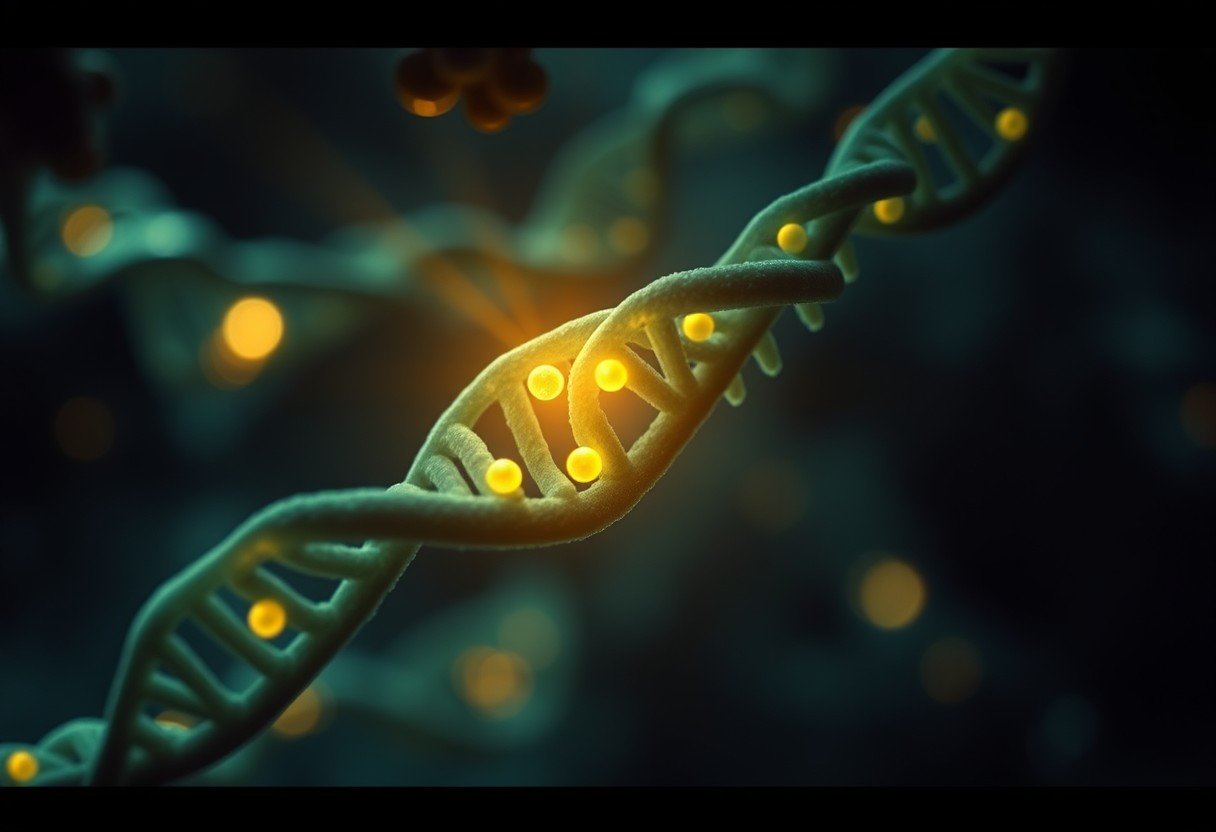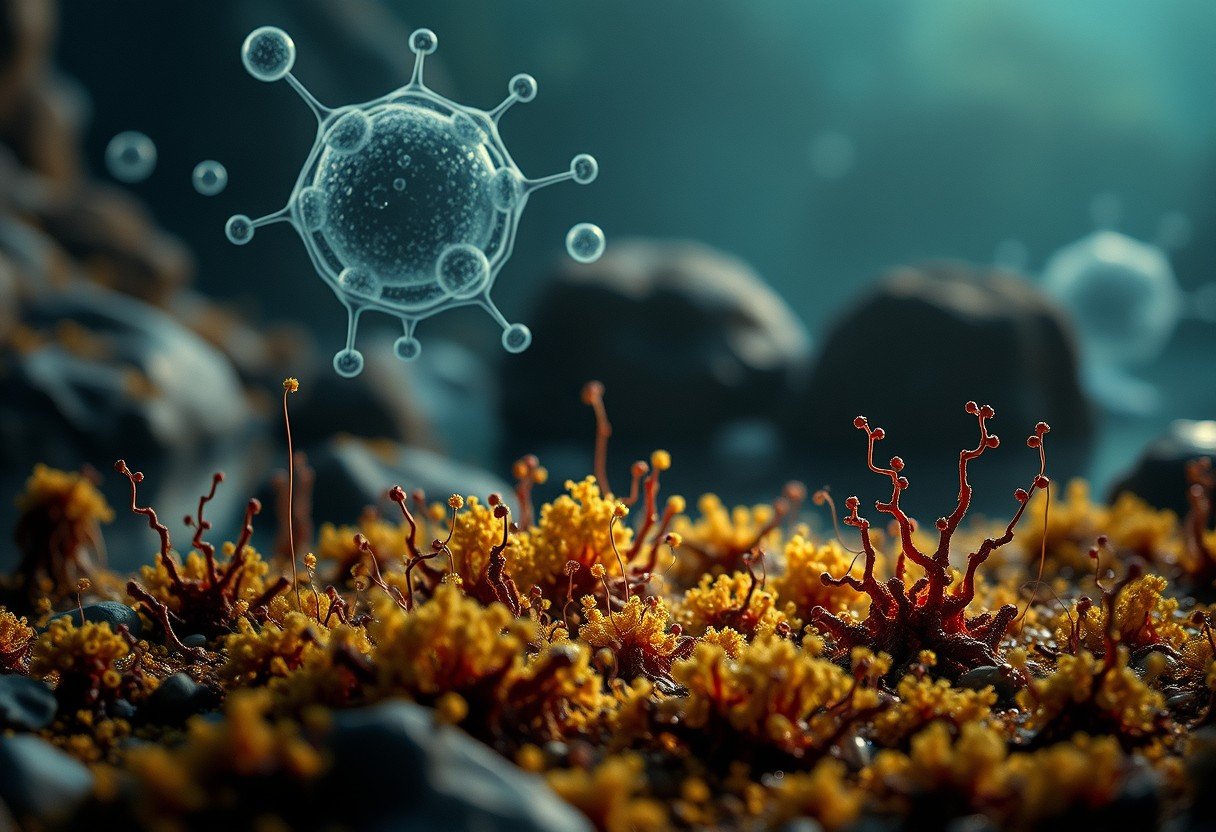When your skin gets exposed to ultraviolet (UV) light, it can suffer damage. The same thing happens to tiny organisms like E. coli. UV light harms their DNA by creating something called thymine dimers. E. coli has a fascinating way to fix this damage using visible light in a process called photoreactivation. This light-powered repair system helps the bacteria survive and keep its genetic information safe, showing just how resilient life can be.
What are Thymine Dimers and Why are They Harmful?
To understand the repair process, we first need to know what’s being repaired. DNA has four main bases, and one of them is thymine. When DNA is hit by UV radiation, two thymine bases that are next to each other can get stuck together, forming a covalent bond. This faulty link is called a thymine dimer.
This dimer creates a kink or distortion in the DNA’s double helix structure. Think of it like a knot in a shoelace; it stops things from working smoothly.
The real problem arises when the cell tries to copy its DNA, a process called replication. The machinery that reads the DNA gets stuck at the thymine dimer, leading to mistakes or mutations. These mutations can be very dangerous for the cell, potentially causing it to stop growing, die, or in more complex organisms, even lead to conditions like cancer. That’s why having a way to fix these dimers is essential for survival.
Introducing Photoreactivation: E. Coli’s Light-Powered Repair Kit
E. coli has a very clever and direct method for dealing with thymine dimers called photoreactivation. As the name suggests, it’s a process that is activated by light. It is one of the most direct ways a cell can reverse DNA damage.
Instead of cutting out the damaged section and rebuilding it, which takes a lot of energy and resources, photoreactivation simply breaks the bond holding the two thymine bases together. This restores the DNA to its original, correct state instantly.
This process is incredibly specific. It only targets thymine dimers caused by UV light and doesn’t interfere with the rest of the DNA. It’s like having a specialized tool that only fixes one particular type of problem, but does it perfectly.
How does the Photolyase Enzyme Work?
The star player in the photoreactivation process is an enzyme called photolyase. This enzyme is designed to find and fix thymine dimers. The process is a beautiful example of molecular machinery at work.
First, the photolyase enzyme scans the DNA and binds directly to the thymine dimer. However, it can’t do anything just yet. It waits for the right trigger, which is visible light, specifically in the blue light range of the spectrum.
Once a photon of light strikes the enzyme, the magic happens. The enzyme uses the light’s energy to break the harmful covalent bond between the two thymine bases. The key components that make this possible are:
- Flavin Adenine Dinucleotide (FAD): This cofactor within the enzyme acts as an electron donor that, when excited by light energy, helps to break the dimer bond.
- A Light-Harvesting Chromophore: This molecule acts like a tiny antenna, absorbing light energy and transferring it to the FAD to kickstart the reaction.
After the bond is broken, the thymine bases return to their normal structure, and the photolyase enzyme releases the now-repaired DNA strand. The entire process can happen in a matter of seconds, making it a highly efficient repair mechanism.
Why is Light-Driven Repair so Efficient?
Photoreactivation offers significant advantages for E. coli, especially for an organism that might live in environments with plenty of sunlight. The main benefit is its incredible speed and efficiency. Unlike other repair methods that involve multiple steps and enzymes, this is a one-step fix.
This speed reduces the chance that a mutation will become permanent during DNA replication. By fixing the damage quickly, the cell ensures its genetic code remains stable and functional. It’s a low-energy solution as well, since it uses an external power source—light—instead of relying entirely on the cell’s own energy reserves.
What Happens When There is no Light?
Photoreactivation is amazing, but it has one obvious limitation: it requires light. So, what does E. coli do in the dark? Fortunately, it has a backup plan called Nucleotide Excision Repair (NER).
NER is a more general-purpose repair system. It doesn’t just fix thymine dimers; it can handle a wide range of DNA damage that distorts the double helix. However, it’s a much more complex and energy-intensive process.
Unlike the direct reversal of photoreactivation, NER involves cutting out the damaged section of DNA. A team of enzymes recognizes the damage, snips the DNA strand on both sides of the dimer, and removes a small segment. Then, another enzyme called DNA polymerase comes in to fill the gap using the opposite strand as a template, and a final enzyme, ligase, seals the strand back together. It’s effective but slower and requires more cellular resources.
How does E. Coli’s Repair Differ from Humans?
While photoreactivation is common in bacteria, plants, and even some animals, many higher eukaryotes, including humans, have lost the gene for photolyase during evolution. Instead, humans rely almost exclusively on Nucleotide Excision Repair (NER) to fix thymine dimers caused by sun exposure.
This difference highlights the diverse evolutionary strategies organisms have developed to protect their DNA. While NER is more versatile, it is also less direct than photoreactivation.
table {
width: 100%;
border-collapse: collapse;
margin: 20px 0;
font-family: sans-serif;
}
th, td {
border: 1px solid #dddddd;
text-align: left;
padding: 8px;
}
thead {
background-color: #f2f2f2;
}
| Organism | Primary Thymine Dimer Repair Mechanism |
|---|---|
| E. coli | Photoreactivation (using visible light) and NER |
| Yeast | Nucleotide Excision Repair (NER) |
| Humans | Nucleotide Excision Repair (NER) |
The absence of photoreactivation in humans is why prolonged sun exposure can be so damaging to our skin, as our cells must rely on the more complex NER pathway to prevent mutations that can lead to skin cancer.
Future Applications in Biotechnology and Medicine
Understanding the simple yet powerful mechanism of photoreactivation in E. coli isn’t just an academic exercise. It opens up exciting possibilities in biotechnology and medicine. Scientists are exploring how to use the principles of light-driven repair for practical applications.
For example, the efficiency of photolyase could potentially be harnessed to create innovative products. Imagine sunscreens that don’t just block UV light but also contain enzymes that actively repair DNA damage on your skin in real-time. This research could lead to new strategies for preventing skin cancer.
In agriculture, this knowledge could be used to engineer crops that are more resilient to high UV radiation, allowing them to grow in harsh environments. By studying E. coli’s elegant solution, we can learn valuable lessons about protecting genetic integrity across all forms of life.
Frequently Asked Questions about E. Coli’s DNA Repair
What is the specific repair process in E. coli that uses visible light?
The process is called photoreactivation. It uses an enzyme named photolyase, which absorbs energy from visible light to directly reverse the damage caused by UV radiation, specifically fixing thymine dimers.
Does photoreactivation work in the dark?
No, photoreactivation is completely dependent on visible light. In dark environments, E. coli must rely on other mechanisms, like Nucleotide Excision Repair (NER), to fix DNA damage.
What enzyme is responsible for photoreactivation?
The key enzyme is photolyase. This enzyme specifically recognizes and binds to thymine dimers, using light energy to break the bond and restore the DNA to its original form.
Do humans use light to repair their DNA like E. coli?
No, humans do not have the photolyase enzyme and cannot perform photoreactivation. Humans primarily use a more complex process called Nucleotide Excision Repair (NER) to remove UV-induced DNA damage.
Why is repairing thymine dimers so important for a cell?
Thymine dimers create distortions in DNA that can block DNA replication and transcription. If left unrepaired, they can lead to mutations, cell death, or the development of cancer in multicellular organisms.
How can understanding this E. coli process help in science?
Studying photoreactivation provides insights that could lead to new technologies. Potential applications include developing advanced sunscreens that repair DNA, engineering UV-resistant crops, and creating new tools for genetic engineering.








Leave a Comment